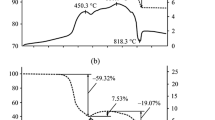Results are presented for a study of the pyrometallurgical treatment of gold-arsenic concentrates with lead osmium-rhenium-containing slags. Conditions are found for preparing alloy ingots consisting of lead, or predominantly of lead sulfide, or both phases. It is shown that with gravitation deposition up to 65–68% osmium is concentrated in 17–25% matte. Gold is almost uniformly distributed over the height of ingots. For industrial application of the results obtained, it is recommended that molten products are poured into a mold heated to 500–550°C, and after natural cooling the lower 25% of alloy is separated for osmium extraction, and gold is extracted from the rest of the alloy by well-known technology. Reduction kinetics are studied for gold, osmium, rhenium, and arsenic. According to kinetic curves, recovery of rhenium in slag proceeds rapidly; osmium recovery ceases in 20–25 min; gold is concentrated in the alloy in 10 min. arsenic is transferred into a gas phase in 10 min, and its concentration in alloy comprises 0.2% on average, and in slags 0.27–0.63%.




Similar content being viewed by others
References
S. T. Shalgymbaev, A. S. Bolotova, and B. Dzhalalov, “Hydrometallurgical technology for processing carbonaceous gold-containing sulfide ores,” Prom. Kazakhstana, No. 1 (82), 50–55 (2014).
V. S. Chekushin and S. V. Olenikova, “Treatment of gold-containing ire concentrates (review of methods),” Izv. Chelyabinsk. Nauch. Tsentra, No. 4 (30), 94–101 (2005).
M. G. Aylmore and D. M. Muir, “Thiosulphate leaching of gold – a review,” Minerals Eng., 14, No. 2, 135–174 (2001).
G. Hilson and A. I. Monhemius, “Alternatives to cyanide in the gold mining industry: What prospects for the future?” J. Production, Nо. 14, 1158–1167 (2006).
D. V. Gradov, D. M. Sizyakov, and M. Neuvonen, “Study of the effect of oxidation of concentrate on thiosulfate leaching of gold,” Zap. Gorn. Inst., 202, 72–74 (2013).
Sh. R. Samikhov and Z. A. Zinchenko, “Study of thiosulfate leaching of gold-arsenic containing ore of the Chore deposit,” Dokl. AN Resp. Tadzhikistan, 52, No. 2, 145–150 (2014).
K. G. Thomas. Research, Engineering Design and Operation of a Pressure Hydrometallurgy Facility for Gold Extraction, Delft, The Netherlands (1994).
I. A. Rojas-Chapana and H. Tributsch, “Biochemistry of sulfur extraction in biocorrоsion of pyrite by Thiobacillius ferrooxidans,” Hydrometallurgy, 59, No. 2–3, 291–300 (2001).
Ji Jinxig, C. A Fleming, G. Paul, and P. Ralph, Patents 6.660.059, 7.066.983 USA, “Method for thiosulfate leaching of precious metal-containing matenais” (2003, 2006).
A. S. Gudkov, G. G. Minaev, and I. A. Zhuchkov, “Evaluation of autoclave oxidation of sulfide concentrates applied to successive thiosulfate leaching of precious metals,” Vestn. IrGTU, No. 3 (43), 80–84 (2010).
K. G. Thomas and D. A. Mike, Developments in Mineral Processing. Advances in Gold Ore Processing, B. A. Wills (Series ed.) (2005), No. 15, pp. 346–370.
C. J. Ferron, Recovery of Gold as Byproduct from the Base-Metals Industries. Advances in Gold Ore Processing, M. D. Adams (ed.) (2005), Chpt. 35, pp. 861–896.
A. Paul and Kohe, Electrodeposition of Gold. Modern Electroplating, John Wiley & Sons, Inc., (2010), 5th ed., pp. 115–130.
A. V. Epiforov, S. S. Gudkov, and S. V. Balikov, Patent 2528300 RF, IPC C22B/00, “Method for treating sulfide raw material containing precious metals,” subm. 11.19.2012, publ. 09.10.2014.
A. V. Epiforov, et al., “Selection of treatment technology for Bereznyakovskoe deposit ore flotation concentrate,” Tsvet. Met., No. 11, 32–35 (2013).
A. P. Epoforov, R. N. Nabiulin, and S. V. Balikov, “Low-temperature autoclave oxidation of tenacious sulfide gold-copper flotation concentrates followed by sulfite leaching of precious metals from oxidized slags,” Izv. VUZ., Prikl. Khim. Biotekhnol., No. 3 (80), 31–38 (2014).
A. N. Zagorodnyaya, Z. S. Abisheva, and A. S. Sharipova, “Contemporary state of ammonium perrhenate production in Kazakhstan,” ibid., 27–30.
A. A. Zharmenov, O. A. Sydykov, E. A. Mazulevskii, et al., Patent 27199 RK, “Method for treating lead-containing materials,” subm. 06.08.2011, publ. 07.05.2013.
A. O. Sadykov, E. A. Mazulevskii, F. A. Berdikulova, et al., “Study of the effect of chemical composition of lead slag on production indices of reduced melt,” Prom. Kazakhstana, No. 8, 73–75 (2011).
Author information
Authors and Affiliations
Corresponding author
Additional information
Translated from Metallurg, No. 11, pp. 77–83, November, 2017.
Rights and permissions
About this article
Cite this article
Mazulevskii, E.A., Kovzalenko, T.V., Seitkhanov, B. et al. Melting of Gold-Containing Concentrates with Copper Production Lead Slags. Metallurgist 61, 1001–1008 (2018). https://doi.org/10.1007/s11015-018-0599-9
Received:
Published:
Issue Date:
DOI: https://doi.org/10.1007/s11015-018-0599-9



